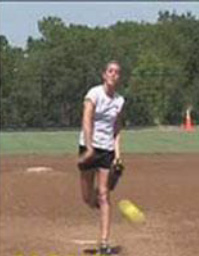| 4 Ways for Pitchers to Dominate in Games |
| By: Cindy Bristow
Provided by: Softball Excellence
Go into any bullpen during any pitching workout and you'll find pitchers doing "spins" and "snaps" and "pitches". Put these same pitchers into a game and their focus shifts to trying to dissect & dominate the batters. Check out how to make this shift happen for your pitchers. If our pitchers have any chance of succeeding during games, they've got to focus during practice on mastering things they'll need during games. Sure "spins" and "snaps" and "pitches" can help pitchers succeed during games, but only if they can use these qualities to attack the strike zone. But far too many pitchers either can't control them, or don't know how to use them to logically weaken a hitter. If we really want to help our pitchers be better in games then we've got to make sure they practice the 4 keys they'll use in attacking hitters. These concepts are how pitch-callers put "pitches" together, how they attack hitter's weaknesses, setup hitters on multiple at-bats (or games), and force batters to hit into the strength of the defense. In other words, a pitcher's job is to get hitters out – and to do that they've got to use the following 4 concepts with every batter and on every pitch: 1. Edges over Fancy –By fancy I mean different types of pitches that sound cool, might even move a lot, but the pitcher can't throw them on a consistent basis to hit the edges of the strike zone. A batter is weakest when she's indecisive, and that happens when she's unsure if the pitch is a Ball or a Strike. One way to create that indecision is to throw pitches on the 4 different edges of the strike zone: Inside, Outside, Top or Bottom. Simply throwing curveballs or screwballs or riseballs or dropballs with no ability to hit the strike zone edges is putting fancy over edges – and that's a recipe for failure in a game. 2. Slow over Fast –Pitchers and coaches are mesmerized by speed. Coaches are constantly telling pitchers they need to throw faster and pitchers are usually obsessed with improving their speed. And yet, speed is the easiest thing for hitters to adjust to. Once the opponents get their timing down against a fast pitcher that pitcher's in trouble. Unless she has a changeup! Throwing changeups need to overrule your need to constantly throw faster. To really disrupt the hitters throw 1 slow pitch for every 4-5 fast ones – if your pitchers can throw those changeups for low strikes, then life gets REALLY good!! 3. Strikes over Balls – This one sounds too obvious to even be listed, but it's amazing to me how many pitchers have pitches they can't throw for strikes, and how many pitch callers actually call these pitches! Keeping the hitter on the defensive makes it difficult for that hitter to use her power and skills to attack, and making sure the hitter is behind in the count (has more strikes than balls) is the easiest way to weaken hitters. Please know that when I say "throw strikes" I'm not talking about meatballs down the middle of the plate. I'm talking about pitches along the edges of the strike zone that your pitcher/s can throw with control. For many pitchers –it's a fastball. Fastballs have gotten a bad rap because people think they're "baby" pitches, but a fastball thrown to a very specific edge of the strike zone can be a deadly pitch! Your pitcher must have the ability to throw more strikes than balls, and if that means she's got to throw fastballs in order to do so then throw fastballs! Strikes over balls means pitchers over hitters! 4. Random over Always –The final way to help your pitchers dominate in games is to use random over always. This might sound bizarre but here's what I mean – after watching a recent scrimmage game in which the pitcher got hit pretty hard, I noticed the pitcher started every single batter out with a curveball. Most batters were right handed (she was too) so the pattern for her first 2 pitches was always Outside followed by Inside. After the game I asked her what her thoughts were in starting every hitter off with an Outside pitch. She said, "my best pitch is my curve so I always throw my best pitch first and then I always throw Inside after I throw Outside." While the reasoning on the surface might sound logical, the problem is that it's predictable. Her "always start Outside" and "always follow Outside with Inside" created an easy pattern that her opponents could quickly figure out and take advantage of. For some unknown reason we've created a lot of "always" in pitching, such as: "always"throw a waste pitch outside after you get 2 strikes, "always" follow Inside with Outside (or visa versa), "always" throw a changeup with 2 strikes... these aren't always true so we need to be more aware of things we say and how they create opportunities for our opponents to beat our predictability. You want them to have to beat your talent, not your patterns! |







